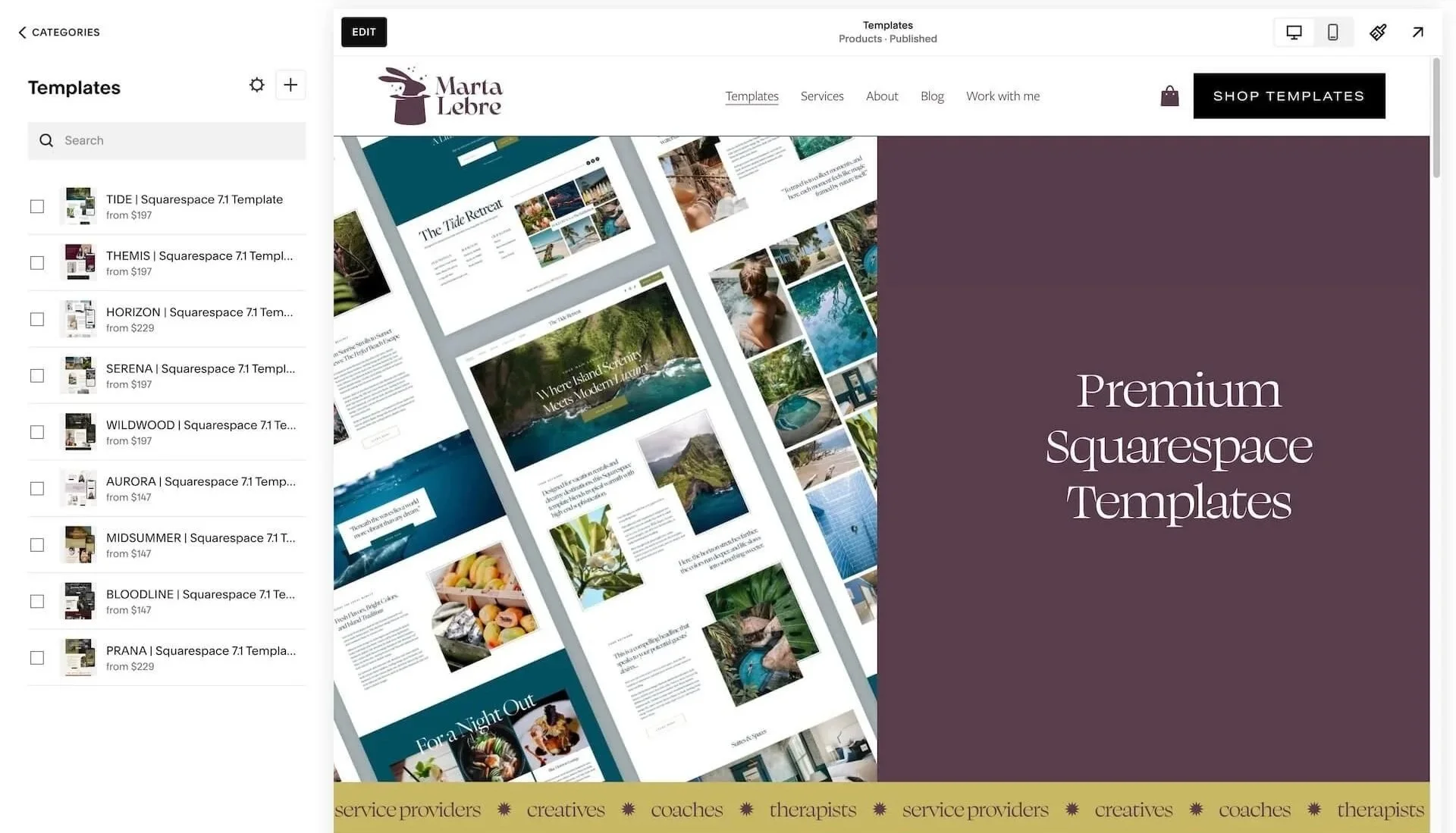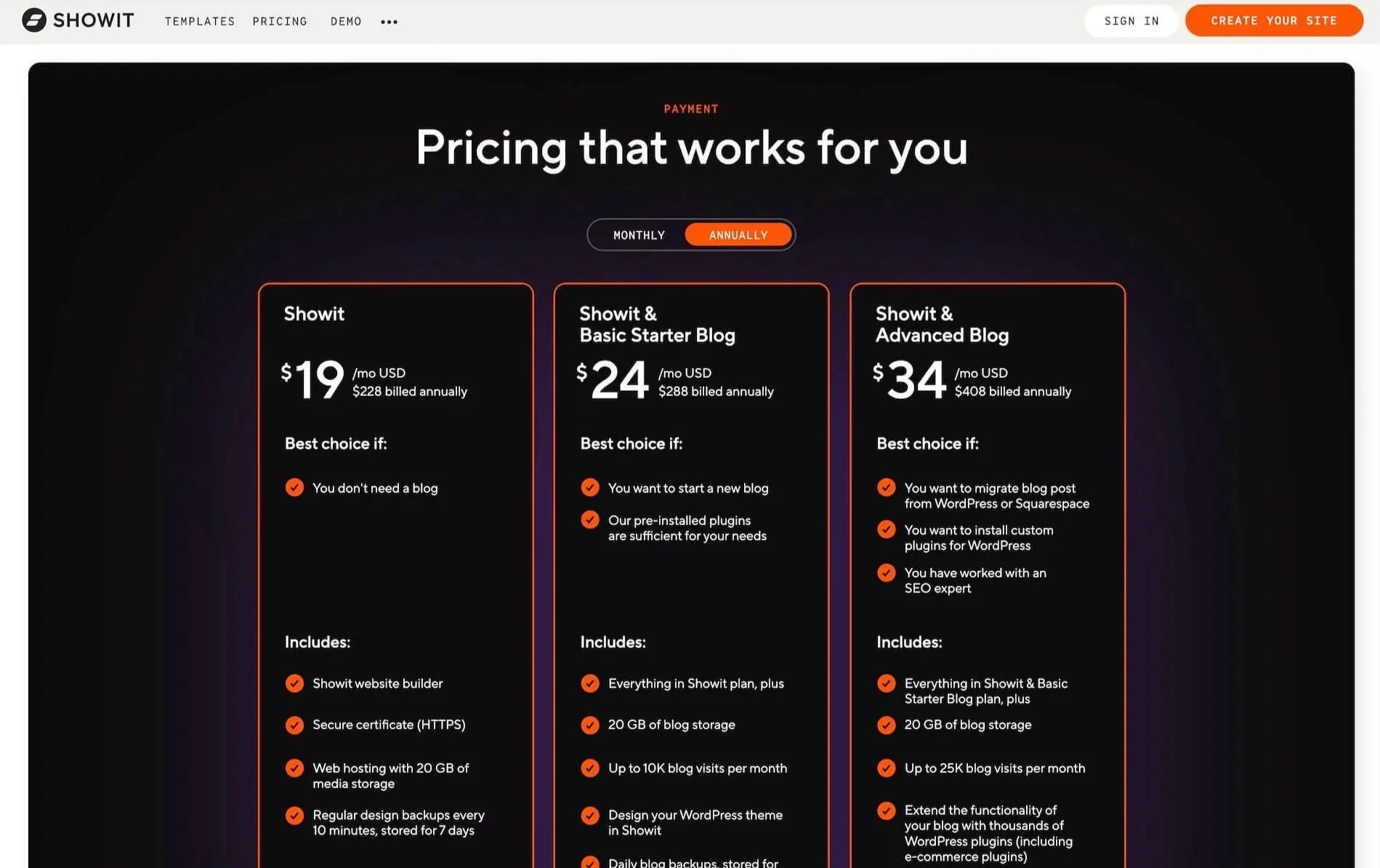Showit vs Squarespace (2025): A Designer’s Honest Take on Two Beautiful Platforms
The “Showit vs Squarespace” debate comes down to one question: do you want limitless design freedom or a platform that’s beautifully simple to use and maintain?
After years of building websites on WordPress, I hit a breaking point.
My clients loved their new designs — but they hated logging in afterward.
Every time they tried to update something, they’d end up lost in the dashboard, accidentally breaking a layout, or calling me in panic because a plugin update sent their site into maintenance mode.
I wanted to find a platform that would make their lives easier — something beautiful, intuitive, and less… emotionally high-maintenance.
That’s when I discovered Showit.
It was love at first sight.
It felt like Canva for websites — drag, drop, move, resize, layer — pure creative freedom.
No grids. No restrictions. Just an open canvas and endless possibilities.
But here’s the thing about freedom: it comes with chaos.
And what started as a design love affair slowly turned into a love/hate relationship.
Showit gave me infinite customization — and that turned out to be both its greatest strength and its downfall.
Eventually, I found myself craving structure, consistency, and a system my clients could actually use confidently.
That’s when Squarespace entered the picture — not as the wild romantic, but as the reliable partner who helps you build a beautiful, functional home you can actually live in.
Tiny disclaimer: a few of the links here are affiliate links. If you buy through them, I get a small thank-you commission. It helps fund my coffee habit and more free content like this one.
Table of Contents
Showit and Squarespace — What are they?
Choosing a platform gets easier when you understand what each one is at its core. Both promise beautiful websites without heavy coding — but they take very different paths to get you there.
What is Showit?
Showit is a purely visual, drag-and-drop website builder that feels like designing in Canva or Illustrator. You can move, layer, and resize anything anywhere — true pixel-level control — and then connect a WordPress blog on the back end for publishing and SEO tools like Yoast. That freedom is why photographers and brand designers adore it: you can create layouts no template would ever suggest.
The trade-off is complexity and craft: spacing, alignment, accessibility, and heading structure are all on you, and without true global CSS you’ll paste styles per page (or host CSS externally) to keep things consistent. It’s magical for perfectionists, but it rewards meticulous workflows and longer build times.
What is Squarespace?
Squarespace is an all-in-one website platform that bundles hosting, security (SSL), templates, blogging, basic SEO, analytics, email campaigns, and ecommerce under one login. Its editor (Fluid Engine) gives you flexible, grid-based design — enough creative freedom to make it yours, with built-in guardrails that keep typography, spacing, and mobile layouts beautifully consistent. Instead of stitching together plugins or multiple dashboards, you get a unified system where most essentials “just work.” That makes Squarespace ideal for non-techy founders, small teams, and creatives who want a site that looks professional, is easy to update, and won’t turn into a part-time IT job.
Showit vs Squarespace: Ease of use & workflow
Choosing a platform is really choosing a daily workflow. Do you want infinite freedom (and infinite decisions), or smart constraints that keep everything consistent? I’ve built custom full sites and templates on both, and the difference shows up the moment you try to make six small edits across the whole site — one platform becomes a graceful glide, the other becomes a scavenger hunt.
Showit — exhilarating freedom, meticulous work
Showit gives you nearly infinite possibilities: custom headers, fancy mega menus, layered hero sections, carousels—you can drag and drop anything anywhere. It’s designer heaven… with a steep learning curve. From-scratch builds take time because every spacing choice, alignment, and breakpoint is on you. If you’re not a designer, it’s very easy to make a gorgeous mess: inconsistent spacing, misaligned elements, headings out of order. And when you change your mind later (new font size, button style, spacing rhythm), you’ll update it manually in every place you used it, pulling your hair out. That level of control is powerful, but it puts you in charge of everything—down to the last 8px.
Showit editor looks pretty much like Photoshop
Squarespace — structured creativity, sane speed
Squarespace works inside a preset system: global colors, font scales, buttons, spacing tokens. Those “constraints” are actually kindness. Fluid Engine is still drag-and-drop, but the grid keeps spacing consistent and typography on a reliable scale. You can’t casually resize a single headline in one random spot (without a little CSS), and that’s exactly why sites stay cohesive. The payoff is huge: builds are much quicker, it’s hard to break consistency, and global changes land everywhere at once—swap a font size or button style in Design Settings and the update rolls across your whole site. It feels less like micromanaging pixels and more like directing the brand.
Clean Squarespace interface = good UX
Showit vs Squarespace: Templates
When it comes to templates, the difference between Showit and Squarespace isn’t just aesthetics—it’s the real scope of what you’re buying or building.
Showit — High-End Creative Templates (with complexity to match)
Showit templates often come with high price tags and high expectations. These are wow-effect layouts—think full-screen image reveals, animation-rich sections, custom grid drops, parallax headers. They’re gorgeous. But here’s the reality from years of experience: if you’re not a pro designer (or working with one), attempting a fully custom build on Showit is a long, detailed process.
Customizing a template is one thing (many designers lean on platforms like Tonic Siteshop for best-in-class Showit themes). But designing from scratch? Unless you’re comfortable with layers, breakpoints, naming conventions, and the missing global CSS/JS controls—you’ll end up spending way more time than you anticipate.
Because while you can add CSS/JS globally on Showit, natively there’s no straightforward global controller: you either manually paste code on every page (quick path to chaos) or host external files and tie them in (for tech wizards only). There are fewer low-cost “starter” templates in the Showit ecosystem compared to more mainstream builders, which means higher initial investment.
Tonic Site shop is the best source of premium Showit templates
Squarespace — Premium Look, More Accessible Customization
Squarespace templates are more affordable ($97 - $347), easy to adapt, and still look professionally designed out of the box. The marketplace (both official and third-party) offers hundreds of themes across industries: business, portfolio, blog, e-commerce.
You won’t get quite the same “anything-goes” visual freedom as Showit, but for many creatives and small businesses that’s exactly the point. Squarespace templates handle typography, mobile optimization, consistent spacing, and responsive design by default.
And if you’re feeling adventurous, you can dive into something truly custom using the BluePrint AI editor or start from a blank canvas—but with helpful guardrails. In short: Squarespace gives you a premium aesthetic that you can actually manage yourself without spiralling into months of design tweaks.
Free Squarespace templates
Blueprint AI will help you create a Squarespce website from scratch fast
| Template Factor | Squarespace | Showit |
|---|---|---|
| Average Price Range | Included in subscription / $0–$200 for premium third-party designs | Typically $500–$1,200+ for premium templates (designer-grade) |
| Number of Templates Available | Hundreds of official + third-party templates across industries | Smaller, boutique ecosystem (best known: Tonic Siteshop, Saffron Avenue) |
| Ease of Customization | Beginner-friendly; quick visual editing with global styles | Advanced; heavy design control but steep learning curve |
| From-Scratch Design | Possible via Blueprint AI or blank layouts; guided by grid | Possible but time-consuming; not recommended for non-designers |
| Global Styling (CSS/JS) | Built-in global style editor + custom CSS block | No native global CSS/JS — must paste per page or host externally |
| Time to Launch | Fast (days to a week) | Longer (weeks+ depending on customization) |
| Best For | Small business owners, creatives, and DIY designers | Professional brand designers seeking total creative freedom |
If you’re looking for something that looks amazing and you have the design capacity (or budget for a designer), Showit can deliver big. If you want something that looks professional and you can manage (or oversee) with fewer headaches, Squarespace is the smarter, faster route.
Showit vs Squarespace: SEO & Performance
When it comes to SEO, both Showit and Squarespace can technically rank well — if the person behind the screen knows what they’re doing. The real difference lies in how easy it is to keep your site optimized over time. One gives you clear structure and automatic optimization; the other makes you wear a part-time SEO manager hat.
Showit — powerful but scattered
Showit isn’t “bad for SEO,” as many designers assume — it’s just manual. The foundation is fine: you can edit titles, meta descriptions, and alt text, and when connected to a WordPress blog, you get full Yoast SEO capabilities for blog posts. But the workflow is… fragmented. You have SEO settings in different places (Showit for pages, WordPress for posts), and because Showit’s design relies on layer naming and order, messy layers can confuse crawlers about what’s what.
You’ll also need to rename images before uploading (there’s no rename-after-upload option), handle URL redirects separately for pages and blog posts, and manually ensure image formats stay lightweight — because Showit doesn’t convert images to WebP automatically. The result? It can absolutely rank well, but it takes a lot of human precision to keep it that way.
Showit SEO Settings for pages
Showit SEO Setting for blog are managed through Yoast
Squarespace — clean, cohesive, and quietly optimized
Squarespace is the opposite kind of SEO platform — it works with you, not against you. SEO settings (titles, descriptions, slugs, redirects, image alt text) live in one tidy interface, and global site settings handle metadata, social sharing, and sitemap generation automatically. Squarespace converts images to WebP, allows you to rename them after uploading, and lets you manage URL redirects for all content in one central place.
There’s no layer chaos, no double-dashboard juggling, and no plugin babysitting. It’s structured in a way that protects you from yourself — you get strong SEO by default, even if you don’t think about it much. And if you do know what you’re doing, you can add custom schema, meta fields, and code injection to push performance even higher.
One caveat — in Squarespace, font size is tied to structure (H1, H2, H3, etc.). To break out of this convention, you need a little CSS (which many of my premium Squarespace templates already include).
Squarespace SEO tools
| SEO & Performance Factor | Squarespace | Showit |
|---|---|---|
| Meta Titles & Descriptions | Built-in for every page and post | Available; scattered between Showit (pages) and WordPress (blog) |
| Heading Structure | Automatically logical and accessible | Dependent on correct layer naming and order |
| Image Optimization | Automatic WebP conversion + rename after upload | No WebP conversion; rename before upload |
| URL Redirects | Centralized redirect management | Handled separately for pages and blog posts |
| Blog SEO Tools | Native SEO controls per post | Full control via Yoast plugin (WordPress) |
| Site Speed & Performance | Optimized CDN + compressed assets + WebP | Decent speed; heavy designs may slow load times |
| Sitemaps & Indexing | Automatic XML sitemap and SSL | Manual or via WordPress plugin |
| Ease of SEO Management | Centralized, simple, low-maintenance | Fragmented, requires more hands-on management |
Showit vs Squarespace: Blogging
If blogging is a big part of your content strategy, the difference between Squarespace and Showit will shape your daily workflow — and your sanity. Both can absolutely handle a content-driven business, but the path there feels very different.
Showit — beautiful, but double the dashboards
First, you don’t have a blog on Showit by default. You need at least the Basic Starter Blog account (2nd subscription tier) and request to connect a blog manually. Showit’s blog actually lives on WordPress, even though it looks like it’s part of your Showit site. You design your post layout visually inside Showit (where the header, sidebar, footer, and typography are controlled), but you write, optimize, and publish your posts inside WordPress.
That means two platforms, two logins, and two learning curves. The upside? You get access to Yoast SEO and all the power of WordPress blogging. The downside? You also inherit WordPress maintenance: plugin updates, theme conflicts, and all the “don’t-touch-that-button” chaos that comes with it.
Still, Showit blogs can look absolutely stunning — designers have full creative control over post layouts, so your blog can look more like a magazine than a CMS. But the technical overhead is real, and for non-techy clients, that split setup can quickly become confusing.
Squarespace — one editor, one flow
Squarespace takes the opposite approach: everything lives under one roof. You design your blog layout, write your content, set SEO and social settings, and publish — all from a single editor. No plugins, no double dashboard, no remembering which platform handles which task.
It may not offer WordPress-level customization (no fancy custom fields or advanced automation), but it delivers what most small businesses need: categories, tags, RSS, SEO fields, image optimization, and scheduling — all neatly integrated. You can even add custom blocks, CTAs, or newsletter signups inside posts with just a few clicks.
The result: Squarespace feels less like a technical project and more like storytelling — smooth, intuitive, and distraction-free.
Showit vs Squarespace for blogging
| Blogging Feature | Squarespace | Showit |
|---|---|---|
| Platform Structure | Built-in blogging system (one dashboard) | Blog hosted on WordPress, designed in Showit |
| Design Control | Customizable within template settings | Full design control via visual editor |
| SEO Tools | Native SEO fields per post | Yoast SEO via WordPress backend |
| Ease of Use | Simple, unified interface | Requires switching between Showit and WordPress |
| Maintenance | None (updates managed automatically) | Regular WordPress updates + plugin management |
| Plugin Support | Limited (mostly built-in features) | Full access to WordPress plugins (depending on plan) |
| Sidebar / Widgets | Possible with custom code or plugin | Depends on template; manual setup via layers |
| Best For | Small businesses, creatives, and coaches who want ease | Designers, photographers, and advanced bloggers |
Showit vs Squarespace: eCommerce
If you’re planning to sell anything online — products, sessions, downloads, or digital courses — this section is where the decision gets easy. Because while Showit technically supports eCommerce, it’s not built for it. Squarespace, on the other hand, was practically born for it.
Showit — possible, but patchy
Showit doesn’t have a built-in store system. That means if you want to sell, you’ll need to get creative. The most common setup is to integrate WooCommerce through WordPress (since your blog already lives there), or to embed checkout tools like ThriveCart, SamCart, or Shopify Buy Buttons.
It works — but it’s a bit like juggling three platforms at once. You’ll design your product page in Showit, manage products and orders in another tool, and handle checkout on a third platform. It’s not beginner-friendly, and even small tweaks (like styling your cart or changing a button color) can turn into a time sink.
For service providers or digital creators who only sell a handful of items or bookings, Showit’s workarounds might be fine. But if you’re building a serious online store? You’ll hit friction fast.
Squarespace — commerce that actually flows
Squarespace’s eCommerce is fully integrated. You can add products, track inventory, send abandoned cart emails, manage taxes and shipping, and connect Stripe, PayPal, and Apple Pay — all inside one clean dashboard. You can even sell digital products, memberships, and subscriptions without touching a single line of code.
It’s fast to launch and easy to maintain. You could literally set up a small shop in a weekend. Squarespace handles design consistency automatically, so your product pages, cart, and checkout all look beautifully on-brand — no duct tape, no third-party chaos.
Showit vs Squarespace for eCommerce
| eCommerce Feature | Squarespace | Showit |
|---|---|---|
| Native Store Functionality | Fully built-in (Commerce plans) | None (requires third-party integrations) |
| Typical Setup | Products, checkout, and payments all in one place | ThriveCart, SamCart, or Shopify Buy Buttons embedded |
| WooCommerce Support | Not needed | Possible via WordPress, but complex |
| Payment Gateways | Stripe, PayPal, Apple Pay (native) | Depends on external checkout tool |
| Inventory & Taxes | Built-in controls for stock and automated tax calculation | Handled externally (or manually) |
| Abandoned Cart Recovery | Automatic (Business + Commerce plans) | Possible via third-party checkout tools |
| Launch Speed | Fast — launch a shop in a weekend | Slow — multiple platforms and custom embedding |
| Best For | Small product shops, service-based businesses, and creators | Designers who sell selectively or via third-party systems |
Showit vs Squarespace: Pricing & Maintenance
When you pick a platform, it’s not just the monthly fee—it’s the hidden time cost, maintenance hassle, template price, plugin stack, and future migration risks. My experience building sites on both platforms taught me this: a lower monthly number can still mean more work, more updates, more overwhelm.
Showit — lighter initial fee, heavier ongoing effort
With Showit your base subscription starts lower ($19/month, $228/year for the website-only tier) and rises if you include a blog or advanced WordPress features ($34/month, $408/year). That looks affordable, yes—but when you factor in the design time (customizing templates, managing layers, maintaining WordPress blog plugins), you’re carrying extra invisible cost. You’ll likely spend more time (and maybe a designer’s hours) keeping spacing consistent, plugins updated, backups done, and integrations running. The hosting is bundled, but the complexity makes it more like managing a mini tech stack.
| Showit Plan | Showit Only | Showit + Basic Starter Blog | Showit + Advanced Blog |
|---|---|---|---|
| Price (2025) | 💵 $19/month (billed annually) |
💵 $24/month (billed annually) |
💵 $34/month (billed annually) |
| Blogging | ❌ No blog | ✅ Basic WordPress blog | ✅ Full WordPress blog with advanced features |
| WordPress Access | ❌ None | ⚠️ Limited access | ✅ Full access |
| Plugin Support | ❌ No plugins | ⚠️ Limited plugins only | ✅ All plugins supported |
| WooCommerce (eCommerce) | ❌ Not supported | ❌ Not supported | ✅ Supported (advanced users only) |
| Yoast SEO | ❌ No | ✅ Yes | ✅ Yes |
| Who It’s For |
• Simple portfolio sites • No blog needed • No plugins or advanced SEO |
• Bloggers • Service providers with simple blog needs • Yoast SEO users |
• Advanced bloggers • eCommerce via WooCommerce • Memberships, LMS, custom plugins • Heavy SEO or custom functionality |
Showit pricing 2025
Squarespace — slightly higher monthly number, much lower maintenance overhead
Squarespace subscription plans run (in 2025) approximately US $16/month (= $192/year, Basic) up to US $52/month ( = $624/year, Advanced), depending on plan and billing frequency. That includes hosting, SSL, updates, and support. The template ecosystem is simpler, plugin chaos doesn’t exist, and maintenance is minimal. What that means in practice: you spend more energy on your business, less on your website. If you choose the right template and get it set up well, you mostly click “publish” and you’re done.
Squarespace also offers add-ons (paid extra): Acuity for scheduling and email marketing tools, which is great for those who want to have a simple business, with everything handled on one platform.
| Squarespace Plan | Personal | Business | Commerce (Basic) | Commerce (Advanced) |
|---|---|---|---|---|
| Price (2025) | 💵 $16/month (annual billing) |
💵 $23/month (annual billing) |
💵 $36/month (annual billing) |
💵 $49/month (annual billing) |
| Blogging | ✅ Yes | ✅ Yes | ✅ Yes | ✅ Yes |
| eCommerce | ❌ No selling | ✅ Sell products ⚠️ 3% transaction fee |
✅ Full store ❌ No transaction fees |
✅ Full store + advanced features |
| Advanced Commerce Features | ❌ None | ⚠️ Limited |
• No abandoned cart • No subscriptions |
✅ Abandoned cart emails ✅ Subscriptions & memberships ✅ Advanced shipping & discounts |
| SEO Features | ✅ Full SEO tools | ✅ Full SEO tools | ✅ Full SEO tools | ✅ Full SEO tools |
| Integrations & Code Injection | ❌ No code injection | ✅ Code injection + integrations | ✅ Code injection + integrations | ✅ Code injection + integrations |
| Best For |
• Simple websites • Portfolio + blog • No selling needed |
• Service-based websites • Small shops (light selling) • Basic eCommerce with 3% fee |
• Growing shops • Full eCommerce • Serious sellers (no fees) |
• High-volume shops • Subscriptions • Abandoned cart recovery • Advanced discount logic |
Squarespace pricing 2025
Showit vs Squarespace: Security & Support
If you’ve ever woken up to a broken site after a plugin update, you know website security isn’t theoretical — it’s emotional. The best platform isn’t just the one that looks good on launch day, but the one that stays stable without constant babysitting.
Showit — friendly team, fragile ecosystem
To their credit, the Showit support team is genuinely kind and responsive. You’ll often get a human answer fast — which is refreshing. But the system itself isn’t fully self-contained. Showit handles the design and hosting for your visual site, yet your blog runs on WordPress, and that’s where the security vulnerabilities sneak in.
WordPress requires constant updates: core updates, plugin updates, and theme compatibility checks. Skip them, and you risk security gaps. Do them too early, and you risk breaking things. (Ask me how I know.) And since Showit doesn’t manage your WordPress side beyond connection setup, that part is entirely on you — backups, malware scans, plugin conflicts, and all.
The platform itself is stable, but when you’re mixing Showit and WordPress, there’s always potential for friction. It’s like owning a beautiful old car — you’ll get where you need to go, but you’ll also get to know your mechanic very well.
Squarespace — security handled, updates invisible
Squarespace is the opposite: closed ecosystem, controlled environment, zero plugin chaos. You never need to update software, patch vulnerabilities, or check SSL — it’s all managed automatically. You don’t even see updates happen; the system evolves quietly in the background while your site just works.
Backups, uptime monitoring, and security layers are all baked in. There’s also 24/7 support via chat or email, an extensive help center, and a vast community of designers and developers sharing tips and code. Squarespace rarely breaks, even under heavy updates, which is why I trust it for my own site and my clients’ businesses.
When I want a platform that lets me focus on creating instead of debugging, Squarespace wins by miles.
| Security & Support Factor | Squarespace | Showit |
|---|---|---|
| Updates | Automatic, invisible to users | Manual WordPress updates + plugin management |
| Security Patches | Handled by platform globally | Requires user vigilance on WordPress side |
| SSL / HTTPS | Built-in and automatic | Included, but must ensure proper configuration on blog |
| Backups | Automated server-side backups | Showit covers design backup; WordPress backup manual or via plugin |
| Downtime Risk | Very low (managed hosting) | Low for Showit side; WordPress adds maintenance risk |
| Customer Support | 24/7 live chat + email + large documentation base | Responsive human support, smaller team |
| Troubleshooting Needed | Rare; system self-manages | Occasional; especially post-update |
| Peace of Mind | ✅ “It just works.” | ⚠️ Great team, but mixed environment adds maintenance stress |
Who Each Platform Is Best For
Choosing between Squarespace and Showit isn’t really about features — it’s about your personality, priorities, and tolerance for tech chaos. Both platforms can produce jaw-droppingly beautiful websites; the question is how much time and mental bandwidth you’re willing to invest to get there.
Showit — for the perfectionists and visual rebels
Showit is for designers and artists who live for creative control. You want to build layouts that don’t exist anywhere else, layer textures and type until it feels like art, and don’t mind managing a few extra moving parts to make it happen. You probably have an eye for detail, a high tolerance for tech, and a love-hate relationship with WordPress. You’ll accept longer build times and manual tweaks if it means your site looks exactly the way you imagined it.
Squarespace — for the organized dreamers
Squarespace is for the creative entrepreneur who wants their website to feel polished, consistent, and easy to maintain — without hiring a developer every time they change a headline. It’s perfect if you value structure, stability, and design that looks expensive without the drama. You’re the kind of person who’d rather spend the weekend launching your next offer than troubleshooting plugin errors. You appreciate boundaries (even in design), and you love a system that quietly handles the boring stuff while you focus on your craft.
| Profile / Priority | Squarespace | Showit |
|---|---|---|
| Technical Skill Level | Beginner to intermediate | Intermediate to advanced (designers thrive here) |
| Design Control | Structured flexibility within the grid | Unlimited creative freedom (and decisions) |
| Time to Launch | Fast — days to a week | Slow — weeks or longer, depending on design |
| Maintenance Style | Set-it-and-forget-it simplicity | Ongoing tinkering and WordPress maintenance |
| Ideal Users | Coaches, small biz owners, therapists, creatives with limited tech time | Brand designers, photographers, and visual artists |
| Budget Awareness | Predictable cost, lower total ownership | Higher template + setup investment |
| SEO & Performance | Built-in and automatic | Good but manual; requires more attention |
| Emotional Vibe | “My site takes care of itself.” | “I built this masterpiece pixel by pixel.” |
Myths & Misconceptions (and what’s actually true)
Every platform has its fan club — and with fan clubs come myths. I’ve built on both, talked to dozens of clients who’ve tried each, and seen how misinformation keeps people second-guessing their choice. So, let’s clear the fog.
💬 Myth #1: Squarespace is bad for SEO
This one has been haunting Squarespace since 2015, and it’s so outdated.
Squarespace used to be more limited, sure — but in 2025, it’s an SEO-ready system out of the box. Titles, meta descriptions, clean URLs, mobile optimization, SSL, schema for common content types, redirects, and image WebP conversion are all built in. The sites I design on Squarespace routinely rank on Google, even outranking complex WordPress setups that rely on 10 plugins to do the same thing.
If your Squarespace site isn’t ranking, it’s not the platform — it’s the strategy. You still need keyword research, strong copy, and backlinks. But the foundation? Solid.
💬 Myth #2: Showit is only for photographers
It’s true that Showit started as the darling of wedding and lifestyle photographers — its original audience loved how easy it was to layer imagery and text for emotional storytelling. But today, plenty of brand designers, coaches, stylists, and course creators use it too.
The reason the myth stuck is because Showit’s visual editor feels like a photographer’s dream: full creative control, no rigid grid. But it’s not limited by niche — it’s limited by patience. Anyone can use Showit, but it demands designer-level precision and time.
💬 Myth #3: Squarespace templates all look the same
Nope. They look the same only when people don’t change fonts, colors, or layout sections. Squarespace templates share clean, minimal foundations — not identical designs.
The Fluid Engine editor allows total rearrangement of sections, typography, image ratios, and even animation. With a little CSS, your site can feel completely custom. (If you’ve seen my templates, you know 😉)
💬 Myth #4: Showit is easier to use
Showit looks easy because you can drag things anywhere. But that same freedom is what makes it tricky. Without the constraints of a grid, it’s incredibly easy to end up with inconsistent spacing, misaligned elements, or chaotic mobile layouts. The first week feels like Canva; the third feels like Photoshop with rules you have to invent.
Squarespace, on the other hand, limits your chaos. It’s structured for consistency — you drag, drop, and it still behaves. That “limitation” is actually why clients stay sane.
💬 Myth #5: Showit has better SEO than Squarespace
This one circulates because Showit connects to WordPress for blogging — which gives access to Yoast SEO. But that doesn’t automatically make it “better.” It just gives you more knobs to turn. If your page layers aren’t named correctly or your site isn’t properly structured, those knobs won’t help.
Squarespace handles SEO natively, without plugin juggling — and for most small businesses, that’s a huge advantage. You don’t need to micromanage meta tags to rank well. You just need clean structure, quality content, and consistency.
💬 Myth #6: Squarespace can’t be customized
This is another one I hear all the time — and it’s false. You can add custom CSS, HTML blocks, JavaScript, and integrate tools like MemberSpace, Acuity, ThriveCart, or Tally forms. With Fluid Engine and code injection, Squarespace is far more flexible than people think.
The difference? You start from a stable base instead of reinventing it from scratch.
💬 Myth #7: Showit is cheaper
On paper, yes — the basic plan is a little less. In practice, no. When you factor in the cost of templates, plugins, third-party checkout tools, and extra design time, Showit usually ends up being more expensive long-term.
Squarespace’s subscription includes hosting, security, analytics, and commerce, so your real cost stays predictable.
Conclusion — Why I Ultimately Chose Squarespace
After years of building websites on every major platform — WordPress, Showit, Wix — I’ve learned that design freedom means nothing if the platform itself isn’t stable, scalable, and sustainable for the people using it.
Squarespace has become my platform of choice because it strikes the perfect balance between creative control and business practicality. It’s fast to launch, simple to maintain, and polished enough to help small businesses look like established brands. While Showit wins on sheer design flexibility, Squarespace wins where it matters most: ease of use, SEO, performance, and peace of mind.
Most of my clients come to me after battling with WordPress plugins or getting stuck mid-build in Showit. They want a platform that just works — one where they can focus on their brand, not their backend. Squarespace gives them that: a consistent, elegant framework that keeps their site secure, cohesive, and adaptable as their business grows.
If you’re tired of managing tech problems instead of building your brand, Squarespace is your clean slate — powerful enough for professionals, simple enough for beginners, and endlessly customizable when you know where to look.
Shortcut Your Setup
Instead of starting from a blank page, explore my Premium Squarespace Templates — handcrafted for service-based entrepreneurs and creative brands who want high-end design without the overwhelm.
Or, if you’d rather have it done for you:
👉 Check out my Template Customization Service — where I tailor one of my templates to your brand, visuals, and goals in just a few days.
Because building your dream website shouldn’t feel like learning another profession — it should feel like stepping into the next version of your business.
Squarespace vs WordPress: Which One’s Really Better for Small Business?
Squarespace vs GoDaddy Website Builder: Which Is Better for Service-Based Small Businesses?
How to Build a Squarespace Website Fast (That Looks Professional & Actually Converts)
Squarespace Web Designer Pricing: Real Costs, Packages & What’s Worth Paying For
Squarespace SEO Review: Performance, Features & Real Results
Squarespace Templates vs Custom Website: Which One’s Right for You?
Why Squarespace Is the Best Builder for a Therapy Website (and How I Know)
Is Squarespace Good for eCommerce? Honest Review, Pricing, and Real Performance
Showit vs Squarespace — FAQs
-
For most small businesses, yes. Squarespace is more affordable, easier to maintain, and handles SEO and eCommerce natively. Showit gives you more design control, but that control comes with more decisions, more updates, and more setup time. Designers love Showit; entrepreneurs usually thrive on Squarespace.
-
Absolutely. It’s not an instant import (the platforms are too different), but you can migrate your content manually — text, images, and SEO data — and rebuild your layouts in Squarespace. If you’re already using Showit for blogging, WordPress makes exporting your posts easy.
-
Squarespace has a slightly higher monthly fee, but includes hosting, security, commerce, analytics, and templates. Showit looks cheaper upfront, but once you add a premium template, WordPress plugins, and eCommerce integrations, the total cost is often higher.
-
Yes — if you crave total creative freedom and don’t mind the extra tech. Showit is ideal for designers who want to create completely custom layouts. Squarespace, on the other hand, is perfect for design-savvy entrepreneurs who still want control but prefer structure and ease.
-
Yes. The “Squarespace SEO is bad” myth is long outdated. Squarespace automatically generates clean URLs, structured metadata, mobile-friendly layouts, and fast-loading pages — everything Google cares about. The rest comes down to your content and keyword strategy.



